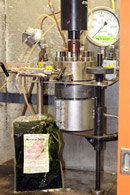EPA, DOE, and the Center for Resource Solutions are sponsoring competitive awards that recognize commitment and achievements in green power.
The Ministry of Education and Research has opened its Green Talents competition; deadline for application is June 20.

Disposing of outdated IT not only helps mitigate environmental risks but also delivers energy cost and productivity benefits.
The researchers compared energy use of a conventionally managed corn and soybean system with two low-input systems that used more diverse crops and manure applications.
The Texas Commission on Environmental Quality has $12 million in grants available; the deadline for application is June 30.

Research by National Science Foundation award winner Peter Sunderland may help engine designers improve the way fuel is injected and burned.
Agency cites increases in anthropogenic greenhouse gas emissions, rising average temperatures, and intense tropical cyclone activity.
By combining conducting and nonconducting domains in the membrane’s nanostructured assembly, researchers improved conductivity performance.
Participants can create their own agenda using a wiki page.
EPA hosts first national building competition to improve energy efficiency
1st Pricing has developed a technology for architects and other designers who use CAD programs.
The U.S. Green Building Council recognizes that there's more than one way to win the gold.

The $2-million American Recovery and Reinvestment Act-funded research combines hydrothermal, catalytic, and biological approaches to make biofuel.

Think of the monitoring possibilities: cathodic integrity for corrosion, pump station efficiency, and tank status.

The American Lung Association's annual State of the Air report attributes gains to emissions control equipment for coal-fired power plants and cleaner diesel fuel and engines.
- By L.K. Williams, EPonline
Using renewable energy certificates and power purchase agreements, the company uses energy from the sun, wind, and water flow to power its operations.
University of Massachusetts and University of Minnesota researchers used methane and carbon dioxide in a single reactor to lower greenhouse gases and make more fuel.
Red dye from purple pokeberries help trap more sunlight in fiber-based solar cells.
Both environmental groups and corporations back the e-Stewards initiative, according to the Basel Action Network.
Sandia National Laboratories recycled 124,333 pounds of electronics scrap through permitted electronics scrap recycling facilities while Oak Ridge National Laboratory
developed net zero energy and sustainability initiatives.